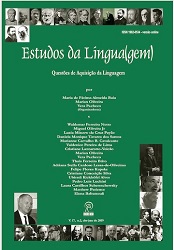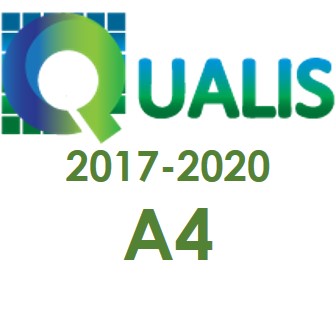An analysis of global and local crosslinguistic influence in L1 Mandarin-L2 English learners of L3 Spanish (Uma análise da influência interlinguística global e local em aprendizes de Espanhol como L3, falantes de mandarim como L1 e inglês como L2)
DOI:
https://doi.org/10.22481/el.v17i2.5346Palavras-chave:
Aquisição de L3; Fonética L3; Mandarim; Espanhol; Influência interlinguística.Resumo
The present study investigated L3 phonetic crosslinguistic influence (CLI) in L1 Mandarin-L2 English-L3 Spanish speakers. The objective was to determine whether the L1 or the L2 was a stronger source of CLI in trilingual speakers of three typologically distinct languages, and to examine the extent to which L2 and L3 proficiency play a role. Two analyses were performed. In the global analysis, Spanish-speaking judges (N=22) listened to passages read by L1 Mandarin-L2 English-L3 Spanish speakers (N=17) with varying levels of L2 and L3 proficiency and attempted to identify the speakers’ native language. In the local analysis, the L3 production of the Spanish trill was examined, with the goal of determining whether the L1 or L2 was a more frequent source of transfer. The two analyses revealed that both the L1 and L2 were possible sources of transfer, although the L1 was a stronger source overall. L2 and L3 oral proficiency were not significant factors, revealing that other factors may be better predictors of the source of transfer. These findings are discussed in reference to their compatibility with the Typological Primacy Model and the L2 Status Factor Model.
O presente estudo investigou a influência fonética interlinguística (CLI) em falantes de mandarim como L1, inglês como L2 e espanhol como L3. O objetivo foi determinar se a L1 ou a L2 era uma fonte mais forte de CLI em falantes trilíngues de três línguas tipologicamente distintas, e examinar até que ponto a proficiência de L2 e L3 desempenham um papel. Duas análises foram realizadas. Na análise geral, juízes hispânicos (N = 22) escutaram passagens lidas por falantes de mandarim como L1, de inglês como L2 e de espanhol como L3 (N = 17) com diferentes níveis de proficiência da L2 e da L3, e tentaram identificar o idioma nativo dos indivíduos. Na análise local, a produção da vibrante múltipla alveolar da L3 foi examinada, a fim de determinar se a L1 ou a L2 foi uma fonte mais frequente de transferência. As duas análises revelaram que tanto a L1 quanto a L2 foram possíveis fontes de transferência, embora a L1tenha sido uma fonte mais forte no geral. A proficiência oral de L2 e L3 não foi um fator significativo, revelando que outros fatores podem ser melhores preditores da fonte de transferência. Essas descobertas são discutidas em referência à sua compatibilidade com o Modelo de Primazia Tipológica e o Modelo do Status da L2 como fator.
Downloads
Referências
BARDEL, C; FALK, Y. The L2 status factor and the declarative/procedural distinction. In J. Cabrelli Amaro, S. Flynn, & J. Rothman (Eds.), Third Language Acquisition in Adulthood (pp. 61-78). Amsterdam, NL: John Benjamins, 2012.
BLANK, C. A; ZIMMER, M.C. A transferência fonético-fonológica L2 (francês)-L3 (inglês): Um estudo de caso [Phonetic-phonological transfer in L2 (French)-L3 (English): A case study]. Revista de Estudos da Linguagem 17, 207–33, 2009.
CABRELLI AMARO, J; WREMBEL, M. Investigating the acquisition of phonology in a third language – a state of the science and an outlook for the future. International Journal of Multilingualism, 13(4), 395-409, 2016.
CHANG, S-E. Degree and direction of foreign accent in L2 and L3 Korean speech. In The Scottish Consortium for ICPhS 2015 (Ed.), Proceedings of the 18th International Congress of Phonetic Sciences. Glasgow, UK: The University of Glasgow, 2015.
CORTÉS MORENO, M. Dificultades lingüísticas de los estudiantes chinos en el aprendizaje del ELE. Carabela, 52, 77-98, 2002.
CORTÉS MORENO, M. Dificultades lingüísticas del español para los estudiantes sinohablantes y búsqueda de soluciones motivadoras [Linguistic difficulties of Spanish for Chinese speaking students and a search for motivating solutions]. SinoELE, 10, 173-208, 2014
DUANMU, S. The Phonology of Standard Chinese. Oxford, UK: Oxford University Press, 2000.
DUANMU, S. The phonology of standard Chinese. Oxford, UK: Oxford University Press, 2007.
FLYNN, S; FOLEY, C; Vinnitskaya, I. (2004). The cumulative-enhancement model for language acquisition: Comparing adults' and children's patterns of development in first, second and third language acquisition of relative clauses. International Journal of Multilingualism, 1(1), 3-16, 2004.
GABRIEL, C; KUPISCH, T; SEOUDY, J. VOT in French as a foreign language: A production and perception study with mono-and multilingual learners (German/Mandarin-Chinese). In NEVEU, F. G ET AL (Eds.), SHS Web of Conferences (Vol. 27). Les Ulis, FR: EDP Sciences, 20016
HAMMARBERG, B; HAMMARBERG, B. Re-setting the basis of articulation in the acquisition of new languages: A third language case study. In HAMMARBERG, B. (Ed.), Processes in third language acquisition (pp. 74-85). Edinburgh, UK: Edinburgh University Press, 2005.
HUALDE, J. I. The sounds of Spanish. Cambridge, UK: Cambridge University Press, 2005.
KOPEČKOVÁ, R. Crosslinguistic influence in Instructed L3 child phonological acquisition. In PAWLAK, M; ARONIN, L. (Eds.), Essential Topics in Applied Linguistics and Multilingualism (pp. 205–24). Cham: Springer International Publishing, 2014.
LADEFOGED, P; MADDIESON, I. (1996). The sounds of the world's languages. Oxford, UK: Blackwell Publishers, 1996.
LEE, W. S. An articulatory and acoustical analysis of the syllable-initial sibilants and approximants in Beijing Mandarin. In OHALA, J. J. Y. ET AL (Eds.), Proceedings of the International Congress on Phonetic Sciences 1999 (pp. 413-416). San Francisco, CA: The Regents of the University of California.
LLAMA, R; CARDOSO, W. Revisiting (Non-) Native Influence in VOT Production: Insights from Advanced L3 Spanish. Languages, 3(3), 30, 2018.
LLAMA, R; CARDOSO, W; COLLINS, L. The influence of language distance and language status on the acquisition of L3 phonology. International Journal of Multilingualism, 7(1), 39-57, 2010.
Llama, R; López-Morelos, L. P. VOT production by Spanish heritage speakers in a trilingual context. International Journal of Multilingualism, 13(4), 444-458, 2016.
LLOYD-SMITH, A; GYLLSTAD, H; KUPISCH, T. Transfer into L3 English. Global accent in German-dominant heritage speakers of Turkish. Linguistic Approaches to Bilingualism, 7(2), 131-162, 2017.
PATIENCE, M. (2018). Acquisition of the Tap-Trill Contrast by L1 Mandarin–L2 English–L3 Spanish Speakers. Languages, 3(4), 1-34, 2018.
PUIG-MAYENCO, E; GONZÁLEZ Alonso, J; ROTHMAN, J. A systematic review of transfer studies in third language acquisition. Second Language Research, 1-34, 2018.
PYUN, KS. A model of interlanguage analysis – The case of Swedish by Korean speakers. In B. HUFEISEN, B; FOUSER, R (Eds.), Introductory Readings in L3 (pp. 55-70). Tubingen, DE: Stauffenberg, 2005.
QIN, Z; JONGMAN, A. Does second language experience modulate perception of tones in a third language? Language and Speech, 59(3), 318-338, 2016.
SYPIAŃSKA, J. Multilingual acquisition of vowels in L1 Polish, L2 Danish and L3 English. International Journal of Multilingualism, 13(4), 476-495, 2016.
ROTHMAN, J. L3 syntactic transfer selectivity and typological determinacy: The typological primacy model. Second Language Research, 27(1), 107-127, 2011.
ROTHMAN, J. (2015) Linguistic and cognitive motivations for the typological primacy model of third language (L3) transfer: Considering the role of timing of acquisition and proficiency in the previous languages. Bilingualism: Language and Cognition, 18(2), 179-190, 2015.
SOLÉ, M. J. Aerodynamic characteristics of trills and phonological patterning. Journal of Phonetics, 30(4), 655-688, 2002.
TREMBLAY, M-C. L2 influence on L3 pronunciation: Native-like VOT in the L3 Japanese of English-French bilinguals. Paper presented at the Satellite Workshop of ICPhS XVI, Freiburg, Germany, August 3–4, 2007.
WREMBEL, M. L2-accented speech in L3 production. International Journal of Multilingualism, 7(1), 75-90, 2010.
WREMBEL M. Foreign accentedness in Third Language Acquisition; the case of L3 English. In CABRELLI AMARO, J; Flynn, S; Rothman, J (Eds.) Third Language Acquisition in Adulthood (p. 281-309). Amsterdam, NL: John Benjamins, 2012.
WREMBEL, M. Foreign accent ratings in third language acquisition; the case of L3 French. In KLIRNCZAK, E. W; SHOCKEY, L. R. (Eds.), Teaching and Researching English Accents in Native and Non-native Speakers (pp. 29-45). Berlin, DE: Springer Verlag, 2013.
WREMBEL, M. (2014). VOT patterns in the acquisition of third language phonology. Concordia Working Papers in Applied Linguistics, v. 5, p. 750-770, 2014
WREMBEL, M. In search of a new perspective: Cross-linguistic influence in the acquisition of third language phonology. Poznań, PL: Wydawnictwo Naukowe UAM, 2015.
Downloads
Publicado
Como Citar
Edição
Seção
Licença
Autores que publicam em Estudos da Língua(gem) concordam com os seguintes termos:
Estudos da Língua(gem) mantém os direitos autorais das contribuições publicadas e disponibiliza seu conteúdo gratuitamente por meio do portal. Autores têm permissão e são estimulados a publicar e distribuir seu trabalho online em repositórios institucionais ou na sua página pessoal, com reconhecimento de autoria e créditos de publicação inicial nesta revista, indicando endereço online.






